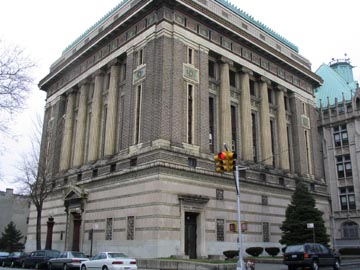Brooklyn Masonic Temple
Christopher Gray explains the innovative architecture of the Brooklyn Masonic Temple in Fort Greene:
Nearly cubic, and roughly 100 feet on a side, the temple is marble, rough-textured brick and glazed terra cotta. The horizontals of the base and upper section contain the verticality of the middle section, a screen of pilasters and engaged columns. Architectural critics gave the temple rave reviews — but it does not, at first glance, look that spectacular.
So what is so great about this building?
Hewlett and his partners rethought several accepted practices, like the glazed terra cotta columns. To reduce the number of joints, architects tend to make columns out of the largest pieces possible. But terra cotta shrinks during the firing process, and the larger the mold, the harder it is to produce pieces close to specification, and the more prominent the joining.
With the Brooklyn Masonic Temple, the architects went in the counterintuitive direction, firing not three or four large sections per column, but about 50 much smaller elements. The resulting joints are so numerous they become part of the design, rather than merely interruptions.
The architects also used color with sophistication. The nearly monochrome shade of the marble base gradually evolves to a festive splash of sienna, green, yellow, cream and blue at the cornice and frieze. The cream-colored column drums were fired with a slight amber tone in the fluting, emphasizing the natural shading in the recessed grooves, and adding a color accent.
The designers also reconsidered normal bricklaying practices. Instead of the usual course-on-course brickwork for the wall surfaces, they produced oversized brick units by stacking the bricks in pairs, with dark mortar between the paired units. The design gives a massiveness that a traditional one could not.
Although the glazed terra cotta was considered nearly self-cleaning, today the Brooklyn Masonic Temple has lost much of its punch. Although the Masons have kept the brick, terra cotta and even roof cresting intact, soil has collected all over the terra cotta, substantially dimming its original brilliance.
Some buildings do not benefit from cleaning, and this might be one of those. But in the temple’s present condition, the original design can only be imagined.

Bonus Point: A Walk Through Fort Greene.
Posted: October 5th, 2004 | Filed under: Architecture & Infrastructure, Brooklyn


